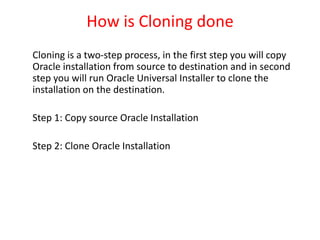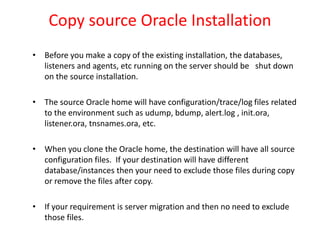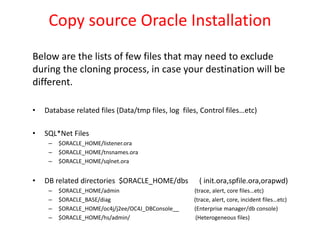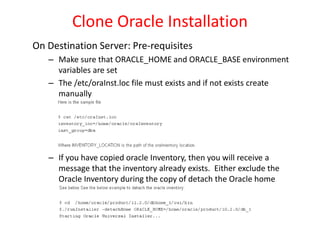Cloning an Oracle Home or Oracle Install.pptx
- 1. Cloning an Oracle Home or Oracle Install Satishbabu Gunukula, Oracle ACE • 18+ Years of Experience in Database Technologies and specialized in high availability solutions. • Masters Degree in Computer Applications • Written articles for major publications • Oracle Certified Professional Oracle 8i,9i,10g • Oracle Certified Expert Oracle 10g RAC http://www.oracleracexpert.com
- 2. Program Agenda • Overview of Cloning • When Cloning useful • Methods of Cloning • How is Cloning done – Copy source Oracle Installation – Clone Oracle Installation • Summary • Q& A
- 3. Overview of Cloning • Starting from 10g onwards, Oracle supports cloning and users can easily clone existing Oracle installations • Cloning is a process of copying an existing installation to a different server or location. Cloning is similar to an Oracle installation except Oracle universal installation performs the actions in a special mode called “clone mode”. • The source and destination servers should have same configuration and packages installed in order Oracle cloning to work • The cloning process works by copying all files from the source Oracle home to the destination Oracle home, and files which are not part of the source instance will not be copied to the destination location
- 4. When Cloning useful When it comes to a server upgrade or migration, database administrators will have to question whether to clone or install the Oracle binaries – If you need to create a new installation with many patches, then cloning enables you to create a new installation with all patches applied to it in one step and eliminate manual installation. – To create an installation that is the same as Production for Development/Testing purpose – If you need to create Oracle home and deploy it to many hosts – If you need to quickly deploy an instance and the applications
- 5. Methods of Cloning Below methods available to clone the Oracle installation – Clone using “perl clone.pl” : In this method you need to install DB Console so that the required Perl files will be installed in $ORACLE_HOME/clone/bin. – Clone using “runInstaller” : In this method you need to install DB Console – Clone using “runInstaller in silent” mode: In this method you will be using same “runInstaller” in non-interactive mode
- 6. How is Cloning done Cloning is a two-step process, in the first step you will copy Oracle installation from source to destination and in second step you will run Oracle Universal Installer to clone the installation on the destination. Step 1: Copy source Oracle Installation Step 2: Clone Oracle Installation
- 7. Copy source Oracle Installation • Before you make a copy of the existing installation, the databases, listeners and agents, etc running on the server should be shut down on the source installation. • The source Oracle home will have configuration/trace/log files related to the environment such as udump, bdump, alert.log , init.ora, listener.ora, tnsnames.ora, etc. • When you clone the Oracle home, the destination will have all source configuration files. If your destination will have different database/instances then your need to exclude those files during copy or remove the files after copy. • If your requirement is server migration and then no need to exclude those files.
- 8. Copy source Oracle Installation Below are the lists of few files that may need to exclude during the cloning process, in case your destination will be different. • Database related files (Data/tmp files, log files, Control files…etc) • SQL*Net Files – $ORACLE_HOME/listener.ora – $ORACLE_HOME/tnsnames.ora – $ORACLE_HOME/sqlnet.ora • DB related directories $ORACLE_HOME/dbs ( init.ora,spfile.ora,orapwd) – $ORACLE_HOME/admin (trace, alert, core files…etc) – $ORACLE_BASE/diag (trace, alert, core, incident files…etc) – $ORACLE_HOME/oc4j/j2ee/OC4J_DBConsole__ (Enterprise manager/db console) – $ORACLE_HOME/hs/admin/ (Heterogeneous files)
- 9. Copy source Oracle Installation Things to note during the copy – Oracle 11g has permissions are more restrictive files and exclude the below files during the copy or tar • $ORACLE_HOME/bin/nmo • $ORACLE_HOME/bin/nmb • $ORACLE_HOME/bin/nmhs – From 11g and higher, add these files to the exclusion list, they’ll be created by root.sh script later in the cloning process. – If any other products are installed/configured but not required at destination, then you need to exclude those files as well.
- 10. Copy source Oracle Installation On Source Server : Copy Oracle Installation using “tar” Note: You can also use “cp”, “scp” or any other copy tools. – Create a exclude list – Create a tar file by excluding files or directories which are not required using below command
- 11. Copy source Oracle Installation On Destination Server: – Create directory structure and set the environment variables such as ORACLE_HOME, ORACLE_BASE, etc. – Copy the tar file to destination server and unpack.
- 12. Clone Oracle Installation On Destination Server: Pre-requisites – Make sure that ORACLE_HOME and ORACLE_BASE environment variables are set – The /etc/oraInst.loc file must exists and if not exists create manually – If you have copied oracle Inventory, then you will receive a message that the inventory already exists. Either exclude the Oracle Inventory during the copy of detach the Oracle home
- 13. Clone using “perl clone.pl” Here is the syntax
- 14. Clone using runInstaller Here is the Syntax
- 15. Clone using “runInstaller in silent” Here is the Syntax
- 16. Clone Oracle Installation On Destination Server: Post-clone tasks • To complete the cone you should log in as “root” and run $ORACLE_HOME/root.sh – # /home/oracle/product/11.2.0.4/dbhome_1/root.sh • In Unix & Linux platforms run “changePerm.sh” for version 10g and older – #/home/oracle/product/10.2.0/db_1/install/changePerm.sh – o /home/oracle/product/10.2.0/db_1
- 17. Summary • Benefits of Cloning • Methods available to Clone • Known Common Issues
Editor's Notes
- #2: 1

















